In 1756, the Reverend Francis Gastrell decided he was being importuned too much by tourists. Unfortunately for him, the 15th-century gabled retreat he had bought in Stratford-upon-Avon was New Place, the former and final home of William Shakespeare. Shakespeare was also, supposedly, responsible for the mulberry tree in the garden, ‘remarkably large, and at its full growth’, then blocking the light to the house. Hoping to kill two birds with one stroke of the axe, Gastrell felled the tree and sold the kindling to a local watchmaker, but with the trail of tourists still unabated three years later, he lost his temper, burned the whole house to the ground and quit Stratford under a volley of curses. In 1806, the antiquary Robert Wheler bemoaned how this ‘sacrilegious priest’ had deprived the town of ‘one of its principal ornaments’ (New Place), and ‘most valued relicks’ (the mulberry). In desecrating the ground ‘cultivated by the greatest genius in the world’, Gastrell had demonstrated himself void of ‘true sense, and […] veneration for the memory of our bard’.
Gastrell’s irritation and Wheler’s condemnation both reflect an increasing interest in ‘relicks’, whether personal or architectural, associated with famous figures during the 18th and early 19th centuries. Shakespeare, whose status as Britain’s national poet was solidified during the same period, became one of the most popular subjects for such interest. Certainly, the watchmaker who had bought Gastrell’s firewood lost no time in capitalising on his windfall. Thomas Sharp established himself as a woodcarver, and was soon producing such a volume of souvenirs from ‘the wood of Shakespeare’s mulberry tree’ as to suggest (as Washington Irving would later put it) that the tree in question had been possessed of ‘as enormous powers of self-multiplication as the wood of the True Cross’. Though the word ‘relic’ was generally used more in its literal sense (‘leavings, remains’) than its religious one, it was a distinction easily blurred. Sharp’s success was such that he soon took on an assistant.
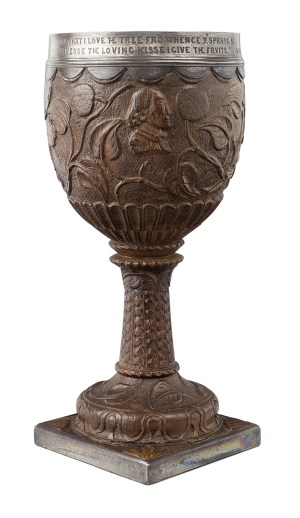
Goblet (c. 1760), Thomas Sharp. Shakespeare Birthplace Trust, Stratford-upon-Avon
One of the most assiduous collectors of relics relating to Shakespeare was the actor David Garrick (1717–79), who, according to an inventory drawn up in 1823 after the death of his wife, owned several pieces of the bountiful mulberry, many ‘not wrought’, and items including ‘a pair of gloves which were Shakespeare’s’ and Shakespeare’s ‘Salt cellar of Delft Ware’. The inventory clerk also recorded several ‘personal memorials’ of Garrick himself, including ‘2 suits of Cloaths, worn & moth eaten’, presented to the actor’s nephews as keepsakes. Like Shakespeare’s gloves, the clothes, with their patina of age and sweat, evoke the physical body of the beloved figure, but the mulberry wood seemed to have a similar organic power. As Gastrell had found to his exasperation, trees were a well-established type of relic; markers of place, living memorials that, even once felled, held out the promise of transhistorical communion with the Great Men from whose older (implicitly, simpler) world they sprung. By 1830, the painter Benjamin Robert Haydon was characterising the search for such communion as a national sickness. ‘You can’t admit the English into your gardens,’ he told his diary, with Gastrellian spleen, ‘but they will strip your trees […] eat your fruit, & stuff their pockets with bits for their musaeums.’
The productions of the mid-century mulberry trade are well represented by a small tobacco stopper, surmounted by a tell-tale balding and moustachioed figure, produced by Thomas Sharp. The stopper-bust’s features are derived from the effigy above Shakespeare’s tomb in Holy Trinity Church, a sculpture traditionally considered to lack the proper distinction of the Bard: Nikolaus Pevsner complained it had the air of a ‘self-satisfied schoolmaster’. For Sharp, its distinction was its location around the corner from his workshop, and this point of convenience, combined with its status as one of the best verified of the dramatist’s (near-) contemporary likenesses, helped underline the relic’s proximity to its subject. The stopper’s coarse carving also attests to the buoyancy of the Stratford relics trade, signalling both the speed of its production and the relatively low price of its sale. Though Sharp claimed to have acquired Gastrell’s tree almost entire, it was not long before bits of it began emerging from other workshops.

Tobacco stopper (c. 1769–99), Thomas Sharp. Shakespeare Birthplace Trust, Stratford-upon-Avon
For Sharp’s customers the proximity of the likeness or location was secondary to the belief that the stopper’s raw material had been (in Wheler’s phrase) something Shakespeare himself had ‘cultivated’. This act of nourishment was, implicitly, comparable to the dramatist’s other creative endeavours and the mulberry, often said to have been planted ‘by Shakespeare’s own hand’, a hand reaching out to the present, offered a connection that, like Garrick’s worn clothes, was bodily as much as spiritual. Sharp solidifies the connection, inviting his smoker to cup their own hand around the poet’s head, enveloping his pate with their palm as they use the stopper to stuff tobacco into their pipe. Similar points of bodily communion inhered in his other relic-artefacts: snuff and toothpick boxes, goblets, sugar tongs, pastry cutters. Almost all are completed with a written maker’s guarantee; in the case of the stopper, the inscription ‘SHAKESPEARE’, on the back, is juxtaposed with the rather more vainglorious ‘SHARP’ on the front.
Many of the items chosen to carry the aura of the Swan of Avon pointed not so much to homespun Englishness – or even Sharp’s inventiveness – as to the increasing disposable income of Britain’s middling sort, and the nation’s participation in emergent international trades such as tobacco (for stoppers), snuff (for boxes) and sugar (for tongs and tea). In fact, the English mulberry had always been connected to commerce. Native to China, the Morus alba and its leaves are beloved of the silkworm and, in 1609, James I had announced his intention to plant 10,000 mulberry trees across the country, attempting to establish an English silk trade to rival the Chinese. The New Place tree may have sprung from a similar commercially minded patriotism. Though the quantity of his productions, unabated till his death in 1799, made his relics something of a local joke, Sharp remained committed to his money-making enterprise. On his deathbed, he swore an affidavit ‘upon the four Evangelists’ that he had never ‘worked, sold or substituted any other wood than what came from, & was part of the [mulberry] tree’, and took his conscience to the grave.
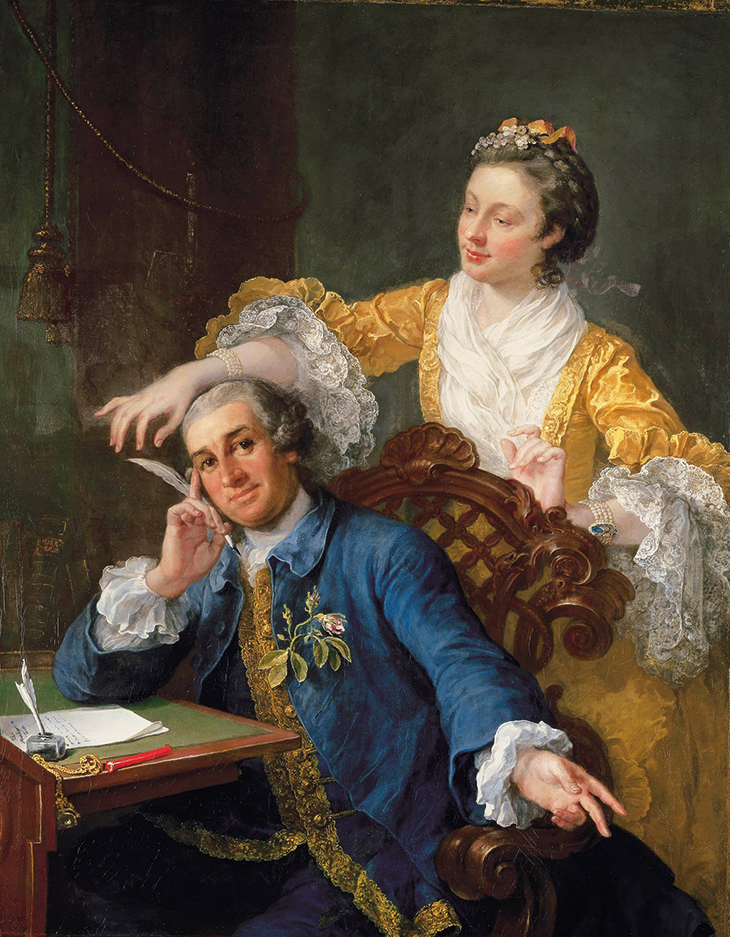
David Garrick with his Wife Eva-Maria Veigel (c. 1757–64), Willliam Hogarth. Royal Collection Trust. © HM Queen Elizabeth II 2020
The comparatively private ‘Bardolatry’ promoted by Sharp’s productions is in contrast to the more public worship of Garrick. Having arrived on the London stage in a sensational debut as Richard III in 1741, Garrick made his relationship with Shakespeare part of his public identity. William Hogarth’s portrait of him playing the part that made him famous became one of the most widely circulated Shakespearean images of the 18th century. Though Shakespeare provided Garrick with some of his most celebrated roles, he also allowed him to transcend the actor’s comparatively low social status, and attain the position of gentleman-scholar, playwright and critic, as Shakespeare’s key interpreter and self-appointed high priest. The ambition is encapsulated in Hogarth’s later portrait of the Garricks – David and his wife, the Austrian dancer Eva-Maria née Veigel (c. 1757–64). Garrick pauses from his composition as if awaiting inspiration, while Mrs Garrick, stealing upon him with her dancer’s tread, takes on the answering allegorical position of a muse. Hogarth had originally placed the couple in a library, in front of an engraved portrait of Shakespeare. Today, though a copy of ‘Shakespeare’ is visible at Garrick’s elbow, the primary reference to the playwright is not the book, but the chair, identified by its distinctive trellis back as a version of the President’s chair of the Shakespeare Club, which Hogarth himself had designed for Garrick in the 1750s.
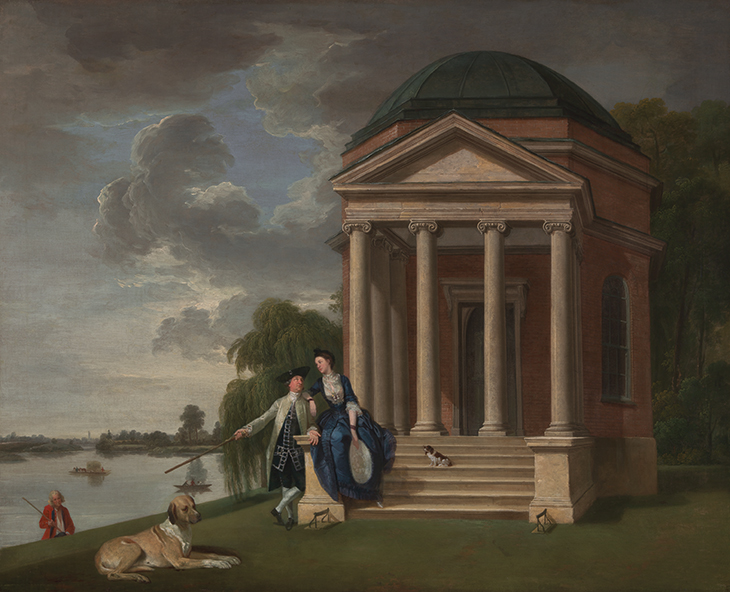
David Garrick and his Wife by his Temple to Shakespeare, Hampton (c. 1762), Johan Joseph Zoffany. Yale Center for British Art, New Haven
Now in the Folger Shakespeare Library, the President’s chair is decorated with allegorical motifs, as well as an inset roundel portrait of Shakespeare. According to Horace Walpole, this was carved by Hogarth’s own hand from a block of mulberry wood, although this bit of mulberry, if it ever existed, has vanished today. The chair’s ultimate destination was Garrick’s ‘Temple to Shakespeare’, the architectural expression of his devotion built on the grounds of his Thameside home, Hampton House. Here, chairs were laid out for visitors to take tea before Shakespeare in marble, by Louis-François Roubiliac, whose sculpting of the playwright was depicted by Adrien Carpentiers in portraits that can be found at the National Portrait Gallery and the Yale Center for British Art. The building’s elegant neoclassical lines, and part of Roubiliac’s statue, loom behind the diminutive figures of Mr and Mrs Garrick (and a gambolling Garrick nephew) in one of two paintings of the grounds by Johan Zoffany in the 1760s. Garrick was so conscious of the social power of the Shakespeare relic that, in his will, he instructed his executors to have boxes fashioned from his stock of mulberry wood, and presented to, among others, the king and the lord chancellor.
In 1769, when the Corporation of Stratford-upon-Avon decided it wanted a bust of Shakespeare for its town hall, it turned to Garrick, beginning its campaign with a request for the actor’s portrait. Then it announced its intention to recognise his vaunted association by presenting him, as ‘the greatest theatrical Genius of the Age […] who has done the highest Honors to the Memory of the immortal Shakespear (a Native of this Place)’, with the Freedom of the Borough, sent in a casket carved from mulberry wood. The Garrick Casket, now in the British Museum, has none of the coarseness of Sharp’s curios. Carved by Thomas Davies of Birmingham, it rests on four silver dragons, and its sides feature high-relief allegorical figures, including Tragedy and Fame, and Garrick himself as Lear in the storm. The allegorical themes, and the prioritising of Shakespeare’s work over his biography, speak to the same kind of high-mindedness incarnated in Hogarth’s chair and, here too, the swirls and natural forms derive from the popular rococo style. The emphasis on the natural world once again highlights the raw material. Just as the Corporation’s statement had stressed that Shakespeare had been ‘a Native of this Place’, the mulberry casket dispatched to London was physical evidence of Shakespeare’s roots in the Warwickshire soil.
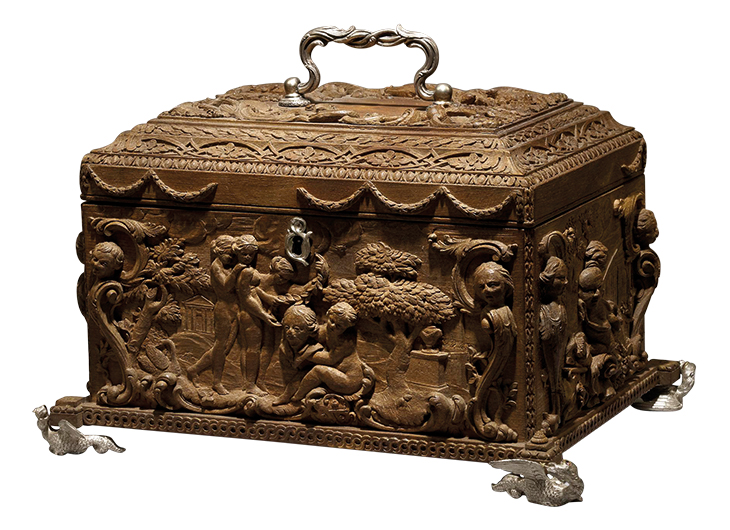
The Garrick Casket (1769), Thomas Davies. British Museum, London. Photo: The Trustees of the British Museum
The competing claims of London and Stratford to Shakespeare would become a point of contention over the century to come, and one that had less to do with history than with what kind of man people wanted to imagine the ‘national poet’ had been. Had the Bard truly felt more at home among the hard-drinking actors of the London South Bank than in the bucolic Midlands landscape? Duly flattered by the Corporation’s attentions, Garrick went some way towards coming out for Stratford. Far from sending a mere portrait, he took himself to the town of Shakespeare’s birth, and there masterminded a multi-day spectacular, a ‘Shakespeare Jubilee’. Over the course of the programme, he turned his attention to the dilapidated former home of John and Mary Shakespeare – New Place having been reduced to ruins – and pronounced the room over Henley Street the site of young William’s arrival on earth. The mulberry tree helped seal the point. On opening night, apostrophising Shakespeare as his ‘god’, the Bard’s devotee performed a hymn to a goblet carved from its wood: ‘As a relic I kiss it,’ he announced. ‘All shall yield to the Mulberry-tree!’
Though the sale of the Garrick estate in the 1820s released a new tranche of mulberry relics to the market, by the 1850s the fruits of this particular tree had largely dried up. Then, in 1863, a storm brought down an oak in Windsor Great Park. This tree, prematurely decayed, had been honoured in the final decades of its standing with the soubriquet ‘Herne’s Oak’, identifying it as the haunted tree that forms the backdrop to the final scenes of The Merry Wives of Windsor. A nearby rival, felled in 1796, also had a claim to the title, and the correct identification had become a point of lively, occasionally bitter, antiquarian dispute. Nonetheless, almost immediately after the storm had passed, Queen Victoria commissioned a carver, William Perry, to take the wood of the most recent claimant and make a series of relics for herself, her friends, and her family.
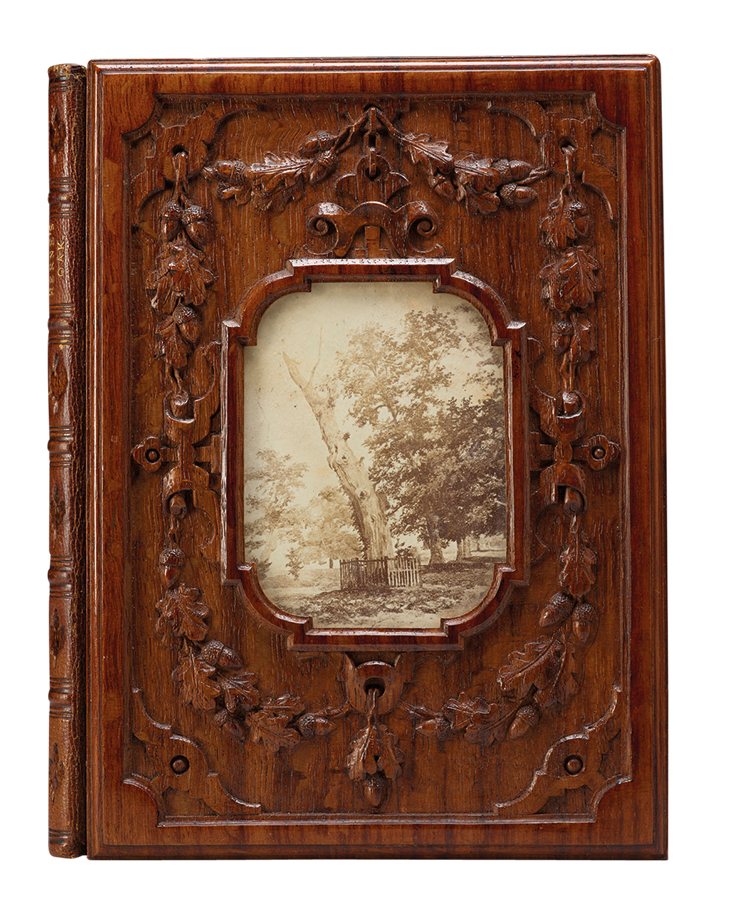
A Treatise on the Identiy of Herne’s Oak (1867), written by William Perry and published by L. Booth. Royal Collection Trust © HM Elizabeth II 2020
In 1867, Perry published a Treatise on the Identity of Herne’s Oak, and bound selected presentation copies in the wood itself. The result is part relic and part antiquarian tract. Where Sharp had been content merely to give (or inscribe) his word, the Treatise advances its argument through diagrams, tables, maps, and text covering oral testimony, literary-critical and dendrochronological analysis. The binding, carved with Renaissance-inspired swags of oak leaves and acorns, makes the point visually, but also frames a photograph of the tree as it had stood, the sepia ink echoing the syrupy, faux-historical varnish over the wood, uniting past and present as only the relic-object can. At the same time, like the dossier it encloses, the photograph makes a claim for objective accuracy more direct than anything before. With the Treatise, scientific proof supplements, supports and ultimately supplants the simple faith the relic asks of the believer.
The fact that neither Perry nor any of his allies or combatants acknowledged the strangeness of advancing such an arsenal of evidence to establish the identity of a declaredly fictional tree probably says something about what the Shakespeare relic had come to mean. For all Thomas Sharp’s guarantees, it is impossible to think that none of his customers put their mulberry-wood souvenirs in their pocket with a wry smile. The very deathbed affidavit acknowledges that any confession would spoil the fantasy. With Herne’s Oak, the focus shifted away from the individual transhistorical connection of the souvenir – the hands of the past touching those of the present – towards the kind of national (and nationalistic) storytelling that Garrick had begun. It is probably not coincidental that this process, with its focus on Windsor, rather than Stratford or London, also allied the Shakespearean relic directly to royalty, another institution that relies, to an extent, on faith masquerading as fact. The mulberry tree must yield, to the old English oak.
From the December 2020 issue of Apollo. Preview and subscribe here.
Unlimited access from just $16 every 3 months
Subscribe to get unlimited and exclusive access to the top art stories, interviews and exhibition reviews.














![Masterpiece [Re]discovery 2022. Photo: Ben Fisher Photography, courtesy of Masterpiece London](http://zephr.apollo-magazine.com/wp-content/uploads/2022/07/MPL2022_4263.jpg)
What the dismantling of USAID means for world heritage